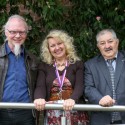By CAM LUCADOU-WELLS
THERE have been times when the waves of new arrivals drove Peter Jarrett crazy.
At flood’s peak, hundreds in a month have poured into the Southern Migrant and Refugee Centre, often moving from other parts of Australia, he says.
One day he asked a man who had come down from Sydney why he moved “down here”.
The reply was: “It’s friendly”.
As Mr Jarrett – the acting leader of the SMRC’s access and information team – now recalls: “From a new arrival’s perspective, that almost means everything.”
The region has a well-won reputation as a receptive and welcoming community.
A shining example was the Enterprise Hostel in Springvale that sheltered thousands of migrants and refugees between 1970-’92.
Around that hostel, services built up such as Springvale Community Aid and Advisory Bureau, a community-initiated hub of language classes, interpreter services and material aid.
“They weren’t all that well prepared but they spoke to each other and to the leaders in the community,” Mr Jarrett said.
It was a forerunner to the SMRC, which opened with federal funding in Walker Street in 1993.
As reported by the Journal at the time, the centre’s inaugural director Melissa Afentoulis said the centre would be a focal point for migrant services in the south-east region.
Her words have proven to be prescient.
The centre has since grown into a 250-strong bank of staff and volunteers with a wealth of languages and backgrounds, helping with settlement, social enterprises and aged care.
It has adapted to wave after wave of new arrivals with different experiences, languages and reasons for settling here.
One of the SMRC directors, Costa Azzam, who was at the opening, is described as the father of the centre.
“At the time there was nothing like this in Dandenong – just a couple of housing groups, a family service, the council.
“Dandenong is the hub of multiculturalism,” he told the Journal recently.
“Whether it’s the council or the community or the SMRC, we always receive the people with open arms.”
SMRC worker Natalia Micsunescu remembers that hospitality when she arrived as a Romanian migrant 25 years ago.
“I didn’t know about settlement services in Romania – we didn’t have refugees,” she said wryly.
She said Greater Dandenong was a ready-made starting point for a new arrival’s life.
“When I took my son to school, the principal was so switched on as to how to talk with children with no English language skills.
“Historically migrants have been part of this community. The advice is go to Dandenong because that’s where we started.”
The place subsequently has been adept at dealing with the“complexity of communities” such as Croatians and Serbs, Turks and Albanians, she says.
She cites Dandenong police’s sophistication in dealing with cultural complexity, and the willingness for community organisations to share settlement experiences.
“We try to encourage our clients to engage, to come here, to visit each other and share their experiences.”
Mr Jarrett adds that employers have long been open to taking on migrants and refugees. In turn those new arrivals become employers themselves.
“Employers know they are going to work hard and stay at their jobs.”
What the next wave of new arrivals might be is anyone’s guess.
“Where there’s a war, generally six or seven years later you see refugees coming to Australia.”







